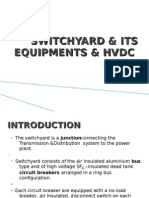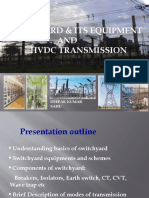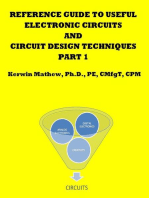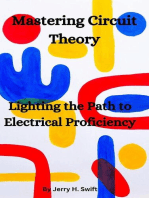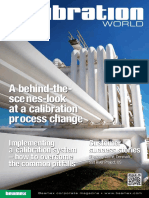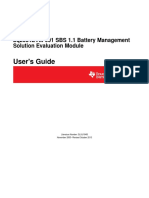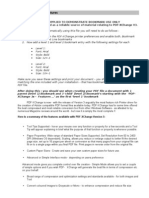Corona Effect
Corona Effect
Uploaded by
Jefferson Nolty GenoviaCopyright:
Available Formats
Corona Effect
Corona Effect
Uploaded by
Jefferson Nolty GenoviaOriginal Description:
Copyright
Available Formats
Share this document
Did you find this document useful?
Is this content inappropriate?
Copyright:
Available Formats
Corona Effect
Corona Effect
Uploaded by
Jefferson Nolty GenoviaCopyright:
Available Formats
1.
) CORONA EFFECT
-The phenomena of violet glow, hissing noise, and creation of the ozone gas contained in the overhead
transmission lines are generally preferred as the corona effect of the transmission line.
-In High voltage power transmission, an immense power delivered through the conductor.
-Factors Lead to Generate the Effect of Corona on Transmission Lines:
1. The appearance of violet glow surrounded by the conductor
2. Hissing sound generated from the conductor
3. Radio interference communication
4. Production of ozone
5. There is power loss in transmission line
2.) SKIN EFFECT
-the tendency of a high-frequency alternating current to flow through only the outer layer of a conductor.
-is due to opposing eddy currents induced by the changing magnetic field resulting from the alternating
current.
3.) ANSI DEVICE NUMBER
-In the design of electrical power systems, identifies the features of a protective device such as
a relay or circuit breaker.
-are used to identify the functions of devices shown on a schematic diagram. Function descriptions are
given in the standard.
4.) DISTANCE RELAY
-The relay whose working depends on the distance between the impedance of the faulty section and the
position on which relay installed.
5.) DIFFERENTIAL RELAY
-defined as the relay that operates when the phase difference of two or more identical electrical quantities
exceeds a predetermined amount.
-works on the principle of comparison between the phase angle and magnitude of two or more similar
electrical quantities.
6.) BUS DIFFERENTIAL RELAY
- is used to protects the Bus Bar in the substation.
This relay acts on Differential current measurement principle. As per the Kirchoff's current law, at any
point, the sum of currents entering the junction is equal to the sum of currents leaving the junction.
7.) TRANSFORMER DIFFERENTIAL RELAY
- Among them differential relay is very commonly used relay for protecting transformers and generators
from localised faults. Differential relays are very sensitive to the faults occurred within the zone
of protection but they are least sensitive to the faults that occur outside the protected zone.
8.) LINE DIFFERENTIAL RELAY
- Current comparison is the term used in the PSRC “Guide for Protective Relay Applications to
Transmission Lines” for all types of line differential relays using current-only as the main operating
criteria. While all line differential relays have similarities, measuring principles may differ.
9.) BREAKER FAILURE RELAY
- A BF function is initiated by all relays tripping the breaker, and as a backup function, it preferably uses a
separate CT and ac wiring. Upon detecting a failure to interrupt, the BF function trips all breakers that
connect sources of the fault current.
- are required to give a rapid trip when the primary circuit breaker does not break properly at e.g. a short
circuit in the network. The faulty section of the network could in this way be tripped separately.
10.) OVER CURRENT RELAY
- A relay that operates or picks up when it's current exceeds a predetermined value (setting value) is
called Overcurrent Relay. Overcurrent protection protects electrical power systems
against excessive currents which are caused by short circuits, ground faults, etc.
11.) RECLOSER
- is an automatic, high-voltage electric switch. Like a circuit breaker on household electric lines, it shuts off
electric power when trouble occurs, such as a short circuit.
12.) LOAD BREAK SWITCH
- is a disconnect switch that has been designed to provide making or breaking of specified currents.
13.) SECTIONALIZER
- is a self-contained, circuit-opening device used in conjunction with source-side protective devices, such as
reclosers or circuit breakers, to automatically isolate faulted sections of electrical distribution systems.
14.) ARC FLASH
- (also called a flashover) is the light and heat produced as part of an arc fault, a type of electrical explosion
or discharge that results from a low-impedance connection through air to ground or another voltage phase
in an electrical system.
15.) IEC 61850
- is an international standard defining communication protocols for intelligent electronic devices at
electrical substations. ... These protocols can run over TCP/IP networks or substation LANs using high
speed switched Ethernet to obtain the necessary response times below four milliseconds for protective
relaying.
16.) SCADA
- is an acronym for supervisory control and data acquisition, a computer system for gathering and analyzing
real time data. SCADA systems are used to monitor and control a plant or equipment in industries such as
telecommunications, water and waste control, energy, oil and gas refining and transportation.
17.) RTAC (REAL-TIME AUTOMATION CONTROLLER)
- Suitable for use in utility substations or industrial control and automation systems, the SEL-3530 Real-
Time Automation Controller (RTAC) provides complete and flexible system control with integrated
security, seamless configuration, unified logic, and reliability.
18.) INVERTER
- is an electronic device or circuitry that changes direct current (DC) to alternating current (AC). ...
Circuitry that performs the opposite function, converting AC to DC, is called a rectifier.
19.) SOLAR PANEL
- Photovoltaic solar panels absorb sunlight as a source of energy to generate direct current electricity.
A photovoltaic (PV) module is a packaged, connected assembly of photovoltaic solar cells available in
different voltages and wattages. Photovoltaic modules constitute the photovoltaic array of a photovoltaic
system that generates and supplies solar electricity in commercial and residential applications.
You might also like
- Substation Visit NelamangalaDocument16 pagesSubstation Visit NelamangalaAJAN A100% (1)
- Introduction of Pakistan Ordnance Factory Wah Cantt: Electrical EngineeringDocument11 pagesIntroduction of Pakistan Ordnance Factory Wah Cantt: Electrical EngineeringNusrat Abbas AwanNo ratings yet
- Switchyard FinalDocument6 pagesSwitchyard FinalPritam SamantaNo ratings yet
- Switch Yard and Its EquipmentsDocument48 pagesSwitch Yard and Its Equipmentsamit joshi86% (14)
- Turbo Generator at NalcoDocument13 pagesTurbo Generator at NalcoSanjay Kumar PandaNo ratings yet
- A Report On Summer Training AT 400 KV Substation Panki: SYAD SAMEER AHMAD (1804528209)Document18 pagesA Report On Summer Training AT 400 KV Substation Panki: SYAD SAMEER AHMAD (1804528209)Nitin SinghNo ratings yet
- PTCUL Substation Training ReportDocument24 pagesPTCUL Substation Training ReportChetan Sharma100% (1)
- Electric CalDocument20 pagesElectric CalRisky RiyanshNo ratings yet
- Power System PDFDocument63 pagesPower System PDFGeda Valley100% (1)
- UPFC Based Distance Relays For Protection of Transmission Systems Employing FACTSDocument4 pagesUPFC Based Distance Relays For Protection of Transmission Systems Employing FACTSShiv TripathiNo ratings yet
- Introduction To Power Systems: 1.1: A.C Transmission SystemDocument23 pagesIntroduction To Power Systems: 1.1: A.C Transmission Systemkar1740No ratings yet
- Overview of SubstationDocument38 pagesOverview of SubstationHarish Pamuru100% (1)
- HAL Project ReportDocument19 pagesHAL Project ReportPandu DonNo ratings yet
- PDU Lab 89Document10 pagesPDU Lab 89Yassir ButtNo ratings yet
- Assignmnet Qs ComprehensiveDocument12 pagesAssignmnet Qs ComprehensiveKhadar A. FarahNo ratings yet
- Project Report Name-Shahil Kumar Singh REG NO - 19110126051 Roll No - 19eee43 Branch - Eee College - Bce BakhtiyarpurDocument20 pagesProject Report Name-Shahil Kumar Singh REG NO - 19110126051 Roll No - 19eee43 Branch - Eee College - Bce BakhtiyarpurShahilsingh SinghNo ratings yet
- TopicsDocument9 pagesTopicsvigneshwarannnNo ratings yet
- Department of Electrical and Electronics Engineering Question Bank Ee2402 Protection and SwitchgearDocument16 pagesDepartment of Electrical and Electronics Engineering Question Bank Ee2402 Protection and SwitchgearSweqZNo ratings yet
- 220 KV SubstationDocument24 pages220 KV SubstationAbhishek MishraNo ratings yet
- IJRPR14284Document6 pagesIJRPR14284rcbp2167No ratings yet
- INTRODUCTION-WPS OfficeDocument6 pagesINTRODUCTION-WPS OfficeAbdulrahaman AbdulraheemNo ratings yet
- CEB Training Report 2Document15 pagesCEB Training Report 2Lakshan Walpita100% (1)
- Gunrock Final TodayDocument57 pagesGunrock Final Today035 Shiva TejaNo ratings yet
- Inplanttrainingreport123 180416062216Document45 pagesInplanttrainingreport123 180416062216asura22novNo ratings yet
- 220 KV Substation ReportDocument38 pages220 KV Substation Reportazad singh92% (12)
- Power System III (1.0)Document62 pagesPower System III (1.0)Emmanuel AgyemangNo ratings yet
- SUBSTATIONDocument12 pagesSUBSTATIONRaaj deepNo ratings yet
- Electrical Q&A Part-4Document15 pagesElectrical Q&A Part-4supermannon100% (1)
- Training Report of Grid Substation: Presented byDocument11 pagesTraining Report of Grid Substation: Presented byତୁଷାର ମିଶ୍ର100% (1)
- Grid Station Report of Internship at IESCO: 2.4.1.2.3. Auto TransformersDocument5 pagesGrid Station Report of Internship at IESCO: 2.4.1.2.3. Auto TransformersMuhammad Asif IqbalNo ratings yet
- Definition of TransformerDocument34 pagesDefinition of Transformerchiragbc94No ratings yet
- 220 KV Sub-StationDocument17 pages220 KV Sub-StationJaat Pankaj Burra100% (1)
- Chapter 2 PPT - Lecture 1&L2Document29 pagesChapter 2 PPT - Lecture 1&L2Biniyam DameneNo ratings yet
- Ee2402 Protection and SwitchgearDocument12 pagesEe2402 Protection and SwitchgearVasudha SinghNo ratings yet
- Three Phase Appliance ProtectorDocument40 pagesThree Phase Appliance ProtectorJeevan PreethuNo ratings yet
- Switchyard & Its Equipment AND HVDC Transmission: Deepak Kumar SahuDocument36 pagesSwitchyard & Its Equipment AND HVDC Transmission: Deepak Kumar SahuDeepak Kumar SahuNo ratings yet
- BSNL (Bharat Sanchar Nigam Limited) : A Presentation OnDocument25 pagesBSNL (Bharat Sanchar Nigam Limited) : A Presentation OnMahesh Kumar NigamNo ratings yet
- Exp.6 Double BusbarDocument11 pagesExp.6 Double BusbarMohammed Abu Al HaijaNo ratings yet
- 33 KV SubstationDocument18 pages33 KV SubstationRohit PatilNo ratings yet
- Anser Key 321 GTS 2018Document24 pagesAnser Key 321 GTS 2018Manoharan Manu100% (1)
- Unit 6: Substations: Prepared By: Er. Madhav P. Nagarkoti (Visiting Faculty)Document43 pagesUnit 6: Substations: Prepared By: Er. Madhav P. Nagarkoti (Visiting Faculty)Dipesh YadavNo ratings yet
- Railway ProjectDocument38 pagesRailway Projectalankar123No ratings yet
- Infrared RaysDocument7 pagesInfrared RaysShree RaiNo ratings yet
- Batch - 14 - Protection Scheme of Busbars and Transmission LinesDocument26 pagesBatch - 14 - Protection Scheme of Busbars and Transmission LinesYugendran Kumaravel100% (1)
- EHV Line ProtnDocument31 pagesEHV Line ProtnSureshraja9977No ratings yet
- Acknowledgement: and His Team of Power Grid Agra Substation For Their Active Support andDocument22 pagesAcknowledgement: and His Team of Power Grid Agra Substation For Their Active Support andMitranshu RajNo ratings yet
- Services and Solutions For Photovoltaic SystemsDocument4 pagesServices and Solutions For Photovoltaic SystemsMarijana IlicNo ratings yet
- Components of Substation CdsDocument12 pagesComponents of Substation CdsSaradaprasan DasNo ratings yet
- General Interview Questions and Answers For Electrical EngineeringDocument4 pagesGeneral Interview Questions and Answers For Electrical EngineeringRohit vermaNo ratings yet
- Technical Subjective QuestionsDocument52 pagesTechnical Subjective QuestionsEngr AHmed Ali Dall100% (1)
- Substation EquipmentsDocument106 pagesSubstation EquipmentsChetansharma2048100% (1)
- Tatva Institute of Technological Studies, Modasa Department of Electrical EngineeringDocument33 pagesTatva Institute of Technological Studies, Modasa Department of Electrical EngineeringTirgar VipulNo ratings yet
- Introduction to Power System ProtectionFrom EverandIntroduction to Power System ProtectionRating: 4 out of 5 stars4/5 (2)
- It Is Quite Another Electricity: Transmitting by One Wire and Without GroundingFrom EverandIt Is Quite Another Electricity: Transmitting by One Wire and Without GroundingNo ratings yet
- Reference Guide To Useful Electronic Circuits And Circuit Design Techniques - Part 2From EverandReference Guide To Useful Electronic Circuits And Circuit Design Techniques - Part 2No ratings yet
- Methods for Increasing the Quality and Reliability of Power System Using FACTS DevicesFrom EverandMethods for Increasing the Quality and Reliability of Power System Using FACTS DevicesNo ratings yet
- Reference Guide To Useful Electronic Circuits And Circuit Design Techniques - Part 1From EverandReference Guide To Useful Electronic Circuits And Circuit Design Techniques - Part 1Rating: 2.5 out of 5 stars2.5/5 (3)
- List of Soft CopiestxtDocument4 pagesList of Soft CopiestxtJefferson Nolty GenoviaNo ratings yet
- SIM PSY 112L Week 5 6 PDFDocument32 pagesSIM PSY 112L Week 5 6 PDFJefferson Nolty GenoviaNo ratings yet
- The Impossible Replication of Desire: Launch Audio in A New WindowDocument1 pageThe Impossible Replication of Desire: Launch Audio in A New WindowJefferson Nolty GenoviaNo ratings yet
- The Impossible Replication of Desire: Launch Audio in A New WindowDocument1 pageThe Impossible Replication of Desire: Launch Audio in A New WindowJefferson Nolty GenoviaNo ratings yet
- A Look Into The World of "Parasite": Name: Program and YearDocument2 pagesA Look Into The World of "Parasite": Name: Program and YearJefferson Nolty GenoviaNo ratings yet
- Supervendor Status 9-30-2020Document24 pagesSupervendor Status 9-30-2020Jefferson Nolty GenoviaNo ratings yet
- JRRRDocument25 pagesJRRRJefferson Nolty GenoviaNo ratings yet
- MARIHA MIN516 Proposed ODU Pad - SITE LAYOUT-signed PDFDocument1 pageMARIHA MIN516 Proposed ODU Pad - SITE LAYOUT-signed PDFJefferson Nolty GenoviaNo ratings yet
- The Seventh Inning: Donald HallDocument3 pagesThe Seventh Inning: Donald HallJefferson Nolty GenoviaNo ratings yet
- Calculus: Part of A Series of Articles AboutDocument4 pagesCalculus: Part of A Series of Articles AboutJefferson Nolty GenoviaNo ratings yet
- Zebra PowerPointDocument18 pagesZebra PowerPointJefferson Nolty GenoviaNo ratings yet
- Watch Tagalog Dubbed Movies: Sorryhttps://epdf - Pub/search/esasDocument1 pageWatch Tagalog Dubbed Movies: Sorryhttps://epdf - Pub/search/esasJefferson Nolty GenoviaNo ratings yet
- Maslow's Hierarchy of Needs: Esteem SADocument23 pagesMaslow's Hierarchy of Needs: Esteem SAJefferson Nolty GenoviaNo ratings yet
- Improving Warehouse Efficiency: With Zebra Wireless Mobile PrintersDocument23 pagesImproving Warehouse Efficiency: With Zebra Wireless Mobile PrintersJefferson Nolty GenoviaNo ratings yet
- Victor VasarelyDocument14 pagesVictor VasarelyJefferson Nolty GenoviaNo ratings yet
- One Sample Statistical Tests, ContinuedDocument57 pagesOne Sample Statistical Tests, ContinuedJefferson Nolty GenoviaNo ratings yet
- Zebra FiskurDocument18 pagesZebra FiskurJefferson Nolty GenoviaNo ratings yet
- LRC LPDocument13 pagesLRC LPJefferson Nolty GenoviaNo ratings yet
- Building Stress Resilience: in Uncertain Times: Jim Kendall, LCSW, CEAPDocument44 pagesBuilding Stress Resilience: in Uncertain Times: Jim Kendall, LCSW, CEAPJefferson Nolty GenoviaNo ratings yet
- Building ResilienceDocument23 pagesBuilding ResilienceJefferson Nolty Genovia100% (4)
- Initial Release Date: WikipediaDocument1 pageInitial Release Date: WikipediaJefferson Nolty GenoviaNo ratings yet
- Zebra ProjectDocument6 pagesZebra ProjectJefferson Nolty GenoviaNo ratings yet
- Scrivener How To PodCastDocument8 pagesScrivener How To PodCasttallerzamyraNo ratings yet
- Oodp Project Report Ra2111028010068Document26 pagesOodp Project Report Ra2111028010068Dhruv AtriNo ratings yet
- CO3053 - Lecture 1 - What Is Embedded SystemDocument21 pagesCO3053 - Lecture 1 - What Is Embedded SystemKhánh Tôn Thất PhúcNo ratings yet
- CalibrationWorld 2015 01 ENGDocument36 pagesCalibrationWorld 2015 01 ENGGordinhors100% (1)
- Data Structures & Algorithms (CS-212) : Week 9: TreesDocument57 pagesData Structures & Algorithms (CS-212) : Week 9: TreesMalik Ghulam HurNo ratings yet
- PS Implementation and Best PracticesDocument3 pagesPS Implementation and Best PracticesmohammedraulmadridNo ratings yet
- BS ISO 17202 2002 Textiles. Determination of Twist in SinglDocument20 pagesBS ISO 17202 2002 Textiles. Determination of Twist in SinglNIRINARISON GaëtanNo ratings yet
- Assignment Two-OSC - COMP 20041Document12 pagesAssignment Two-OSC - COMP 20041bushra habibNo ratings yet
- Board Questions and Answers Q No 5 of 7 SQL Worksheets With AnswersDocument47 pagesBoard Questions and Answers Q No 5 of 7 SQL Worksheets With AnswersSooraj Rajmohan76% (29)
- Inacall 208Document4 pagesInacall 208Jay Ar D MaggayNo ratings yet
- Factorytalk Energymetrix Software Version 2.0: Release NotesDocument4 pagesFactorytalk Energymetrix Software Version 2.0: Release Notesluis.chuquimiaNo ratings yet
- Zend Engine ArchitectureDocument17 pagesZend Engine ArchitecturejosephtaylorNo ratings yet
- English For It: Assignment Topic Unit 14: Video ConferencingDocument28 pagesEnglish For It: Assignment Topic Unit 14: Video Conferencingiam reachNo ratings yet
- Avrae ComandosDocument17 pagesAvrae ComandosReniê Pereira AbelNo ratings yet
- Annual Projection of Project Data Manually and UsingDocument24 pagesAnnual Projection of Project Data Manually and UsingStephanie Jean Magbanua CortezNo ratings yet
- BMC Control-M Campus Setup Guide 05042004Document35 pagesBMC Control-M Campus Setup Guide 05042004jreddyusNo ratings yet
- IMS Registration Call Flow Procedure VoLTE SIP PDFDocument14 pagesIMS Registration Call Flow Procedure VoLTE SIP PDFRitesh100% (1)
- User's ManualDocument79 pagesUser's ManualYann DubéNo ratings yet
- Tuyen Sinh Digital Intergrated Lab - Inha University 2021Document2 pagesTuyen Sinh Digital Intergrated Lab - Inha University 2021DaiNguyenNo ratings yet
- Using MuttDocument44 pagesUsing Mutt4U6ogj8b9snylkslkn3nNo ratings yet
- Mergetool enDocument18 pagesMergetool enLucky HunterNo ratings yet
- User's Guide: bq2084EVM-001 SBS 1.1 Battery Management Solution Evaluation ModuleDocument23 pagesUser's Guide: bq2084EVM-001 SBS 1.1 Battery Management Solution Evaluation ModuleJerry LeeNo ratings yet
- Alpine 9851rDocument34 pagesAlpine 9851rDan Tom EscuNo ratings yet
- ANCHOR - REINFORCEMENT (Metric)Document10 pagesANCHOR - REINFORCEMENT (Metric)Tarek AbulailNo ratings yet
- Digital Open EndedDocument13 pagesDigital Open EndedudayNo ratings yet
- Dell™ Optiplex™ 380 Service Manual - Mini-Tower: Notes, Cautions, and WarningsDocument54 pagesDell™ Optiplex™ 380 Service Manual - Mini-Tower: Notes, Cautions, and WarningsJosip MlakarNo ratings yet
- Digital Malaysia 2021Document102 pagesDigital Malaysia 2021Azri OmarNo ratings yet
- Honey PotDocument17 pagesHoney PotManu KumarNo ratings yet
- Tech Note 1004 - Accessing InBatch Materials Inside of System Platform Using Material Automation Server Object Hosted To Remote NodeDocument5 pagesTech Note 1004 - Accessing InBatch Materials Inside of System Platform Using Material Automation Server Object Hosted To Remote Nodeprofilemail8No ratings yet
- BookmarkDocument2 pagesBookmarkViviana AguirreNo ratings yet



